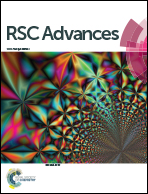Fabrication of different crystallographically oriented TiO2 nanotube arrays used in dye-sensitized solar cells
Abstract
Different crystallographically oriented TiO2 nanotube arrays (NTAs) were successfully fabricated via the anodization of Ti film sputtered on indium tin oxide (ITO) glass. The results indicate that the preferred orientation of TiO2 NTAs with a texture degree f > 0.9 for anatase (004) can be assembled over a wide range of water content in the electrolyte from 1.5 to 6.0 vol%. When the water content is more than 8 vol%, the anatase TiO2 NTA further transforms to a polycrystal type. When compared to the characteristics of DSSCs based on the different oriented TiO2 NTAs, the (004) preferred orientation of TiO2 NTAs possesses the highest power conversion efficiency (PCE) and electron transport rate owing to its excellent orientation.


 Please wait while we load your content...
Please wait while we load your content...